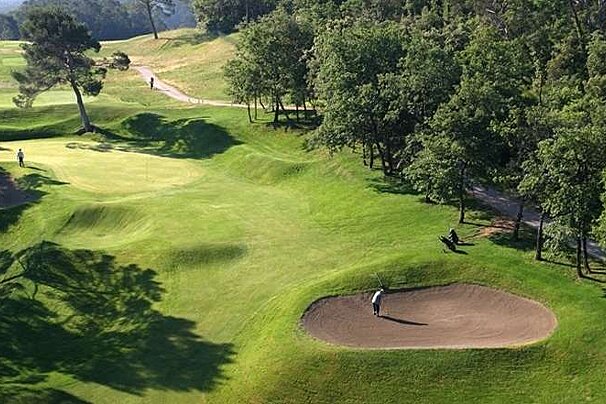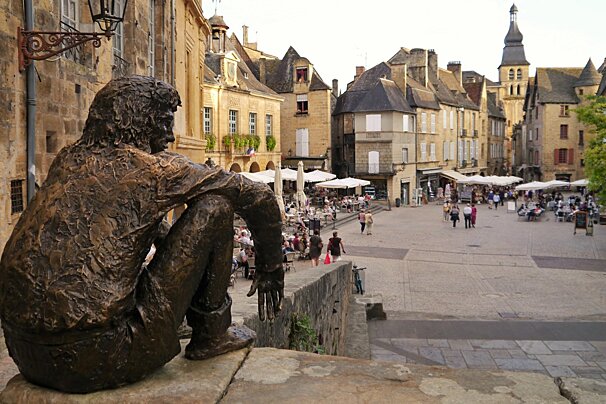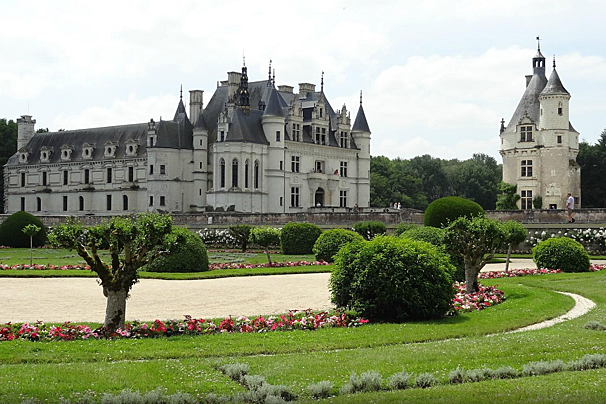Sept Tours Chateau, Courcelles de Touraine
Beautiful château with an outdoor pool and a golf course
This beautiful château of seven towers was created in the 14th century and has been extensively repaired over the years. Originally built in Renaissance style, it also has neo-Gothic features from the 20th century.
Its spacious rooms are decorated in a simple rustic style with great views over the surrounding gardens and attached golf course. Some rooms are located in the towers. All the rooms are equipped with a flat screen TV, a safe, a minibar and a Nespresso machine.
The château has a lovely outdoor pool and jacuzzi making this a great spot to relax. Wine tasting is also available on request.
Jump to
Villas nearby
Villas in La Loire
See all Villas in La Loire-

The Vernelle House, Nazelles
The Vernelle House accommodation is a beautiful 17th century construction. It was completely renovated in 2013.
Hotels nearby
Hotels in La Loire
See all Hotels in La Loire-

La Mare aux Oiseaux Hotel, Saint Joachim
This contemporary and modern hotel, literally translated as the Bird Pond, offers beautifully finished rooms with an oriental feel.
-

Rochecotte Chateau, Saint-Patrice
The grand white Château de Rochecotte was formerly the private estate of the Duchess Dorothée of Dino and Prince of Talleyrand. This remarkable place will take you back to the 18th century with its glorious décor, columned terrace, pretty outdoor pool, ornamental lake and 50 acres of woodland. The château also produces its own Bourgueil wines from its vineyards in nearby Saint-Patrice.
-

Auberge des Templiers Hotel, Boismorand
The original 17th century building of this beautiful former post house has been converted in to a hotel. It was one of the founding hotels in the prestigious Relais & Châteaux hotel chain. The pink brick and half-timbered facade of the inn is characteristic of the Sologne area and a further six further cottages have been added with thatched roofs. Its six hectares of gardens house an attractive outdoor swimming pool.
-

Rivage Hotel, Olivet
27 September 20257 NightsSited on the banks of the river Loiret, this stylish hotel offers immaculate rooms in a wonderful setting. It has pretty gardens with covered walkways and a good restaurant. It's a nice alternative close to Orléans if you don't want to stay in the city.
Price: €724
-

Le Manoir les Minimes Hotel, Anbiose
This charming luxury hotel sits on the banks of the Loire and its sumptuous bedrooms have views of the beautiful Château d'Amboise. Elegantly decorated, with lovely gardens, this is a wonderful choice in heart of Amboise.
-

Du Mail Hotel, Angers
This charming 17th century town house, formerly part of the old Ursuline Convent, has been turned into a lovely contemporary hotel. There is a welcoming courtyard where you can eat breakfast and the rooms are well decorated in a more traditional fashion. Very good value for money.
Things to do nearby
Things To Do in La Loire
See all Things To Do in La Loire-

Erdre Golf Course, Nantes
This golf course is part of the Blue Green group of golf courses.
-

Sologne Golf Course, Ferte Saint Aubin
The Golf de Sologne is the oldest course in the Centre region, and probably one of the most beautiful natural settings.
-

La Loire Bike Tour with Austin-Lehman Travel
Austin Lehman Adventure Travel has been sharing their love of adventure holidays with guests for around 40 years. Their insider's knowledge and extensive contacts in La Loire allow them to offer cultural and artistic experiences and encounters that give guests an in-depth feel for the local people and their way of life.
-

Chateau de Cheverny Golf Course, Cheverny
The golf course of the Château Cheverny has been constructed in the 142 hectares of the historic hunting grounds of the château.
-

Balloon Revolution
Balloon Revolution offer flights over the Touraine region of the Loire Valley allowing you to discover its beautiful châteaux from the sky. Usually launching from the grounds of one of the châteaux, it's an unforgettable experience.
-

Train Touristique de la Vallee du Loir
This train dating from 1950s travels from Thoré to Trôo taking in troglodyte dwellings, Saint-Rimay tunnel, the town of Montoire and Varennes and more.
Restaurants nearby
Restaurants in La Loire
See all Restaurants in La Loire-

Les Banquettes Rouges Restaurant, Blois
This cute traditional French restaurant in Blois serves good quality food on, as the name suggests, red benches! The dishes are innovative and work well, and the is atmosphere charming.
-
Les Hautes Roches Restaurant, Rochecorbon
Chef, Didier Edon, has a Michelin star for his excellent restaurant in the Hautes Roches manor house.
-
Le Relais d'Artemis Restaurant Restaurant, Bracieux
This wonderful restaurant run by Bernard Robin, the renowned chef, used to be a coaching house. Today is serves excellent traditional cuisine in a fine dining setting accompanied by an excellent wine selection. A top dining spot in the Loire with a Michelin star to match.
-
Cak'T Restaurant, Bourges
Charming little coffee shop and lunch spot offering good food on its terrace or tucked away in the cellar. Look out for the decadent dessert selection.
-
Le Petit Comptoir Restaurant, Angers
This small restaurant in Angers serves traditional French cuisine made with locally-sourced fresh market ingredients explained on the classic chalkboard menu.
-
Le Lift Restaurant, Orleans
This modern restaurant is located at the top of an art gallery and its floor-to-ceiling glass windows and terrace offer great views of the quays. Simple white chic tables and chairs with dark walls and a splash of colour give this place a fun trendy feel. The cuisine is modern European, with lots of excellent fish dishes.
Sights nearby
Sights in La Loire
See all Sights in La Loire-
Chateau Langeais, Langeais
At the end of the 10th century Foulques Nerra conquered the site of Langeais and established a château on the promontory. All that remains of the original château are a few traces of the keep. During the second half of the 15th century, Langeais was considered a strategic site. Charles VII's son, Louis XI, therefore decided to build a château there in the face of hostilities from a group known as the League for the Public Weal; dissidents from the high aristocracy. Importantly in 1491, the château was the scene of the dawn wedding between Charles VIII (Louis XI's son) and Duchess Anne of Brittany. The marriage put an end to the strife between France and Anne's independent duchy and paved the way for Brittany eventually being incorporated formally into the French kingdom.
-
Chateau de Luynes, Luynes
This 12th century château is located on the north bank of the Loire. Well maintained, and extravagantly decorated, it was owned by a close friend of Louis XIII, Charles d'Albert who became Constable of France. His family still live in this pretty grey château today.
-
Chateau de Villandry, Villandry
Villandry was completed toward 1536 and was the last of the large châteaux built in the Loire Valley during the Renaissance. It was built by Jean le Breton, one of François I's finance ministers, whose coat of arms can be seen on the gable of the left-hand dormer window. Villandry stayed in the le Breton family until 1754 and then became the property of the Marquis de Castellane, the King's Ambassador, who came from an illustrious noble family from Provence. He built the Classical style outbuildings that you can see on either side of the front courtyard. He also redesigned the interior of the château to meet the standards of comfort of the 18th century. Its redesigned grounds include an impressive vegetable garden constructed in the early 20th century. A cook's delight, these vegetables are now available to buy in season.
-
Chateau d'Usse, Rigny-Usse
This sleeping beauty château, overlooking the Indre river, is thought to have inspired the children's book written by Charles Perrault in the 17th century. Parts of the existing château date back to the 15th century - unfortunately all aspects from earlier dates have been destroyed. However, this picture-book Gothic château with some Italianate features is in immaculate condition. Its interior has been maintained in authentic style and it has a sumptuous king's chamber decorated in gold leaf, just in case a king happened to be passing and drop in!
-
Chateau de Lude, Le Lude
Château de Lude, one of the great châteaux of the Loire Valley, stands at the crossroads of Anjou, Maine and Touraine. The original fortress was built between the 10th and 11th centuries on the banks of the river Loir, in order to defend Anjou from the incursions of the Normans and then the English during the Hundred Years' War. Louis XI's chamberlain, Jehan de Daillon, took possession of the Lude estates at the end of the 15th century. He transformed the fortress into an elegant pleasure palace, which his descendants embellished over two centuries - they added the Renaissance façade in its Italian style and the main courtyard with its marble plaques. The richness and variety of the styles that characterise the Château du Lude are echoed in the interior decoration and furniture. Since the 17th century, the old stronghold surrounded by its wide moat meets an elegant terrace edged by a stone balustrade over 200 metres in length.
-
Prieure de Saint-Cosme
Founded in the 11th century, this priory has long been a place where pilgrims took shelter en route to Santiago de Compostela. In the 16th century Pierre de Ronsard, the French Renaissance poet, became the prior - the priory still features the prior's house with de Ronsard's workroom. The rose gardens pay an appropriate homage to the poet who is buried in the church apse.
Golf-clubs nearby
Golf Courses in La Loire
See all Golf Courses in La Loire-

Domaine de Vaugouard Golf Course, Fortenay-sur-Loing
This 18-hole course is set in the grounds of an 18th-century château which is now a leisure complex with outdoor pool and tennis courts as well as a charming hotel.
-

Sologne Golf Course, Ferte Saint Aubin
The Golf de Sologne is the oldest course in the Centre region, and probably one of the most beautiful natural settings.
-

Saumur Golf Course, Saumur
This relatively new course, set in beautiful Saumur, is a pleasant 9-hole round if you're searching for a change from historical monuments and châteaux.
-

Chateau de Cheverny Golf Course, Cheverny
The golf course of the Château Cheverny has been constructed in the 142 hectares of the historic hunting grounds of the château.
-

Blue Green Avrillé Golf Course, Avrille
In the grounds of the 17th century Château Perrièrre, the golf club is within ancient trees, water features and different plant varieties that create this undulating course offering a diverse round.
-

Nantes Carquefou Golf Course, Nantes
Built in the grounds of the Château de l'Epinay, this 18-hole golf course extends over 67 hectares. The 5,790-metre course has slightly wavy greens and small rivers, ponds and streams. A reasonably easy course with the Martin Hawtree signature.

























